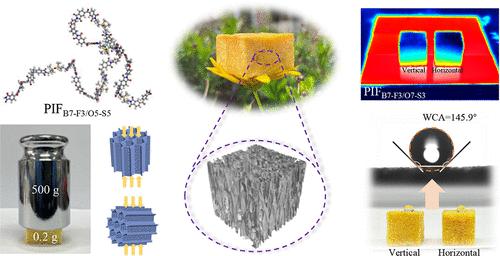含有三氟甲基和硅氧烷部分的轻质共聚聚酰亚胺泡沫,用于隔热和疏水应用
IF 8.2
2区 材料科学
Q1 MATERIALS SCIENCE, MULTIDISCIPLINARY
引用次数: 0
摘要
轻质多孔材料集减震减震、保温隔热、疏水性于一体,在高端工程领域具有广阔的应用前景。本文提出了采用共聚和微波辅助发泡工艺制备含三氟甲基和硅氧烷基团的轻质聚酰亚胺泡沫(pif)。系统探讨了含氟硅聚酯铵盐前驱体粉体及其后续pif的合成、制备及其结构与性能的关系和机理。各向异性孔隙结构的形成归因于微波辅助发泡过程中“自下而上”的定向发泡行为,这使得pif在孔隙生长方向上具有不同的特征。所得共聚pif具有低密度(18.3 ~ 27.7 kg/m3),机械柔韧性增强(抗压强度提高26.2%,压缩响应率在97.5 ~ 99.1%之间),优异的热稳定性(T5% >;485.2℃),以及保温性能。结合微纳孔结构和疏水的三氟甲基和硅氧烷基团的存在,pif表现出优异的疏水性,其水接触角在垂直方向(与孔生长方向平行)和水平方向(与孔生长方向垂直)分别高达145.9°和136.3°。因此,轻质、机械柔韧、隔热、疏水的pif通过该方法成功制备,在航空航天、交通运输、微电子和核能等领域展示了潜在的应用前景。本文章由计算机程序翻译,如有差异,请以英文原文为准。

Lightweight Copolymerized Polyimide Foams Containing Trifluoromethyl and Siloxane Moieties for Thermal Insulation and Hydrophobic Applications
Lightweight porous materials with integrated cushioning and shock absorption, excellent thermal insulation, and hydrophobicity demonstrate a broad application prospect in high-end engineering sectors. Herein, the fabrication of lightweight polyimide foams (PIFs) containing trifluoromethyl and siloxane moieties was proposed by adopting copolymerization and microwave-assisted foaming processes. The synthesis and preparation of fluorine- and silicon-containing polyester ammonium salt (PEAS) precursor powders and subsequent PIFs, as well as the relationship and mechanism between structure and properties, were systematically explored. The construction of the anisotropic pore structure was attributed to the “bottom-up” directional foaming behavior of the microwave-assisted foaming process, which endowed PIFs with different traits with respect to the pore growth direction. The resulting copolymerized PIFs displayed low density (18.3–27.7 kg/m3), enhanced mechanical flexibility (compressive strength improvement of 26.2%, compression response rate between 97.5 and 99.1%), excellent thermal stability (T5% > 485.2 °C), and thermal insulation performance. Combining the micro/nano pore structure with the presence of hydrophobic trifluoromethyl and siloxane moieties, PIFs exhibited exceptional hydrophobicity with the water contact angle, reaching as high as 145.9° in the vertical direction (parallel to pore growth direction) and 136.3° in the horizontal direction (perpendicular to pore growth direction). Therefore, lightweight, mechanically flexible, thermally insulating, and hydrophobic PIFs were successfully prepared by the proposed approach, which demonstrate potential applications in the aerospace, transportation, microelectronics, and nuclear energy sectors, among others.
求助全文
通过发布文献求助,成功后即可免费获取论文全文。
去求助
来源期刊

ACS Applied Materials & Interfaces
工程技术-材料科学:综合
CiteScore
16.00
自引率
6.30%
发文量
4978
审稿时长
1.8 months
期刊介绍:
ACS Applied Materials & Interfaces is a leading interdisciplinary journal that brings together chemists, engineers, physicists, and biologists to explore the development and utilization of newly-discovered materials and interfacial processes for specific applications. Our journal has experienced remarkable growth since its establishment in 2009, both in terms of the number of articles published and the impact of the research showcased. We are proud to foster a truly global community, with the majority of published articles originating from outside the United States, reflecting the rapid growth of applied research worldwide.
 求助内容:
求助内容: 应助结果提醒方式:
应助结果提醒方式:


